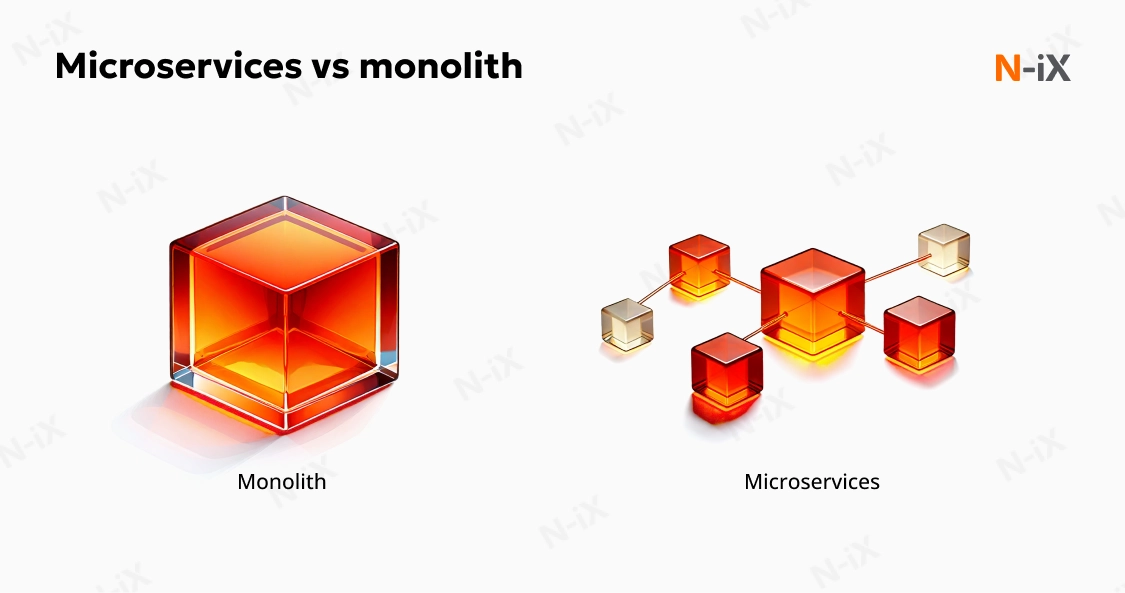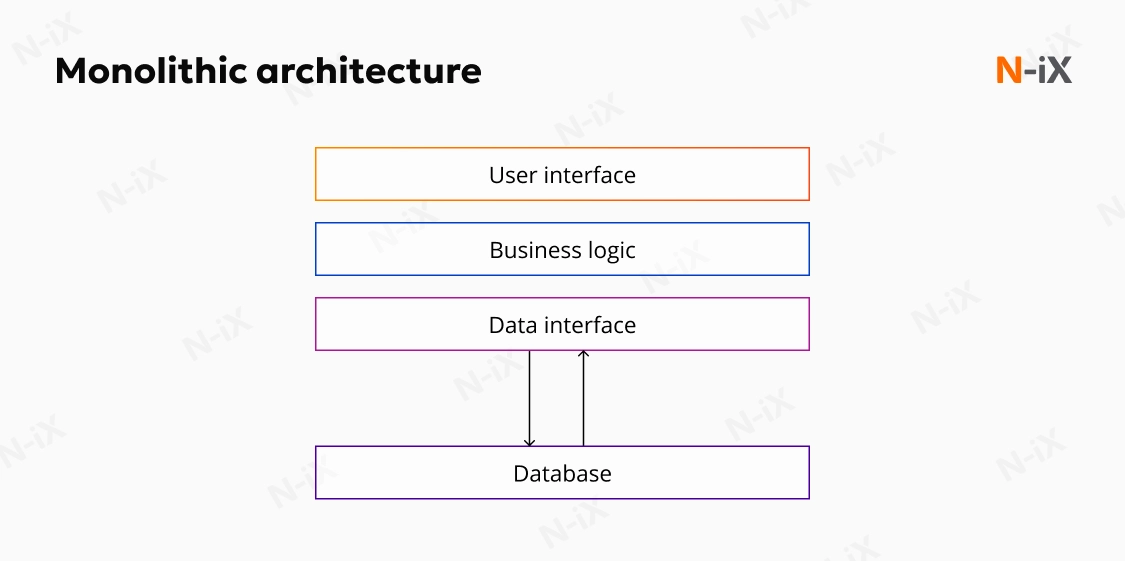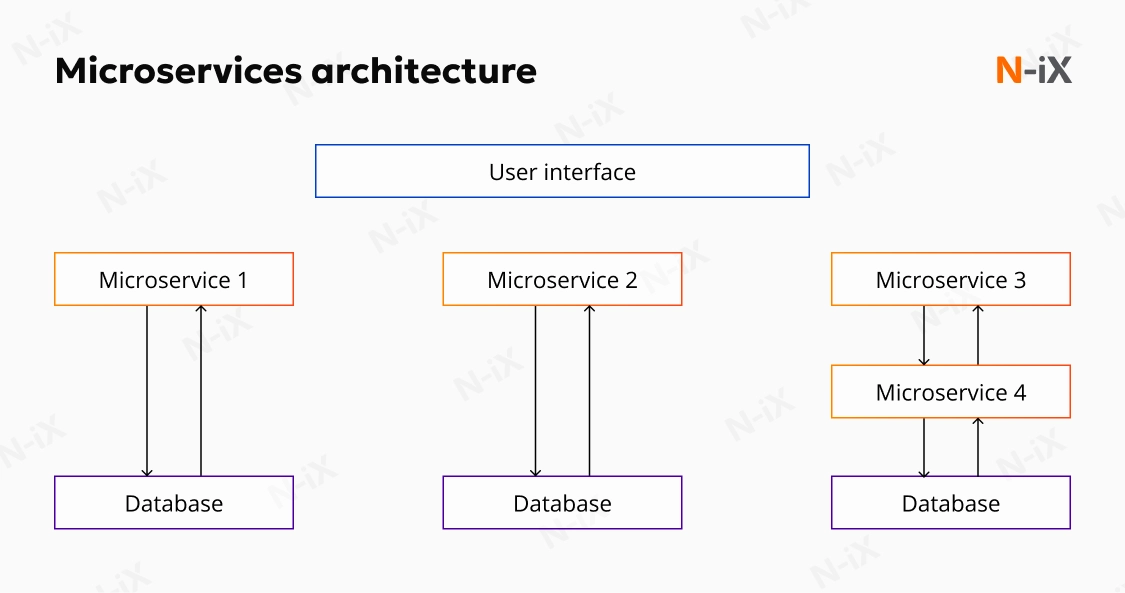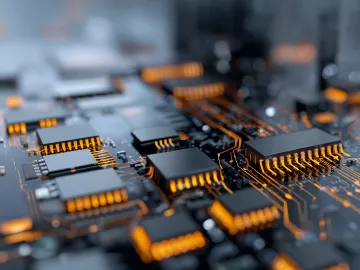When it comes to software architecture, two approaches dominate the conversation: monolithic and microservices. Monolithic architecture has been the traditional choice in custom software development for many years. Meanwhile, microservices have gained significant attention for their ability to offer greater flexibility, scalability, and agility.
As more companies explore the potential of microservices, it's crucial to understand the key differences between the two models, their benefits, and the challenges they present.
In this article, we’ll compare microservices vs monolithic architecture. What is the difference between them? What are the key strengths and weaknesses of both approaches? Let’s dig deeper together.
What is the difference between monolithic and microservices?
Monolithic architecture is a traditional approach where all components are tightly integrated within a single codebase. While this can be simpler to implement initially, it becomes restrictive as businesses grow. Modifying or scaling a monolithic system is often time-consuming, as even small changes can affect large portions of the codebase, leading to higher costs and longer development cycles.
On the other hand, microservices break down software into smaller, independent components, each responsible for a single function. These services communicate through well-defined interfaces, allowing flexibility, scalability, and faster iterations. This approach enables businesses to quickly adapt to changing demands, streamline development, and reduce the risk of disruptions.

Pros and cons of each architecture
In this section, we’ll explore the monolith vs microservices pros and cons. Understanding the strengths and limitations of monolithic architecture vs microservices architecture is essential for you to make informed decisions based on their specific needs, goals, and resources. By evaluating these factors, you can determine which architecture is better suited for you. Let’s take a look at them both.
Monolithic architecture
Monolithic architecture is considered to be a traditional way of building applications. A monolithic application is built as a single and indivisible unit. Usually, such a solution comprises a client-side user interface, a server-side application, and a database. It is unified, and all the functions are managed and served in one place.
Typically, monolithic applications have one large code base and lack modularity. If developers want to update or change something, they access the same code base. So, they make changes in the whole stack at once.
Advantages of monolithic architecture
- Less cross-cutting concerns. We mean concerns that affect the whole application, such as logging, handling, caching, and performance monitoring. In a monolithic application, this area of functionality concerns only one application, so it is easier to handle it.
- Seamless debugging and testing. Comparing monolithic vs microservices architecture, single-tiered applications are much easier to debug and test. Since a monolithic app operates as one indivisible unit, you can run end-to-end testing much faster.
- Prompt and simple deployment. Another advantage of a unified architecture juxtaposing monolith vs microservices is fast and easy rollout. In monolithic applications, you do not have to handle many deployments, just one file or directory.
- Easier development. As long as the monolithic approach is a standard way of building applications, most qualified engineers have the right knowledge and capabilities to develop a monolithic application.
Disadvantages of monolithic architecture
- Code complexity. You can build a tower to a certain height with no trouble, but as it grows, eventually the foundation's instability will cause it to start shaking. The same thing is with a monolith. When a monolithic application scales up, it becomes too complicated to understand and segregate the ownership of the pieces. In addition, a large codebase within one application is harder to maintain.
- Highly interdependent components. Implementing changes in such a large and complex application with high coupling might become a challenge. Any code change affects the whole system, so it poses more technical challenges and has to be thoroughly coordinated.
- Limited scalability. While choosing between a monolithic architecture vs microservices, consider that you won’t be able to scale the software components independently, only the whole application.
- New technology barriers. It is extremely problematic to apply cutting-edge technology in a monolithic application because then the entire software has to be rewritten.

Learn how to migrate from monolith to microservices
Microservices architecture
While a monolithic application is a single unified unit, a microservices architecture breaks it down into a collection of smaller independent units. These units carry out every application process as a separate service. So, all the services have their own logic and databases, and they perform specific functions.
Within a microservices architecture, the entire functionality is split up into independently deployable modules that communicate with each other either through defined methods called APIs or message brokers. Each service covers its own scope and can be updated, deployed, and scaled independently.
Advantages of microservices over monolithic:
- Independent components. Comparing microservices vs monolithic architectures, the first architecture type offers much greater flexibility—all the services can be deployed and updated independently. Moreover, a bug in one microservice influences only a particular service rather than the entire application. Also, adding new features to a microservice application is much easier than to a monolithic one.
- Easier maintenance. Split up into smaller and simpler components, a microservice application is easier to understand and manage. You just concentrate on a specific service that is related to a business goal you have.
- Better scalability. Another advantage of the microservices approach is that each element can be scaled independently. So the entire process is more cost- and time-effective than with monoliths when the whole application has to be scaled, even if there is no need for it. In addition, every monolith has limits in terms of scalability, so the more users you acquire, the more problems you have with your monolith. Therefore, many companies end up moving to microservices.
- Flexibility in choosing the technology. The engineering teams are not limited by the technology selected from the start. Once you face the choice of software architecture—monolithic vs microservices, keep in mind that with separated services, you are free to apply various technologies and frameworks for each of them.
- Isolation of services. Any fault in a microservices application affects only a particular service and not the whole solution. Therefore, all the changes and experiments are implemented with lower risks and fewer errors.
Disadvantages of microservice architecture:
- Extra complexity. Since a microservices architecture is a distributed system, you must choose and set up the connections between all the modules and databases. Also, as long as such applications include self-sufficient services, they all must be deployed independently.
- System distribution. A microservices architecture is a complex system of multiple modules and databases, so all connections must be handled carefully.
- Cross-cutting concerns. When creating a microservices application, you will have to deal with several cross-cutting concerns. They include externalized configuration, logging, metrics, and health checks.
- Difficulties with testing. Many independently deployable components make software testing much harder than it is with a monolithic architecture.

Microservices architecture vs monolithic architecture: Which suits you best?
If you still have doubts about choosing between microservices vs monolithic architectures, go through our checkpoints. You’ll be able to compare them with where you stand and your business goals to make a final decision:
4 reasons to go for microservices
- You need to develop a complex and scalable application. The microservices architecture will make scaling and adding new capabilities to your application much easier. So, if you plan to build an extensive application with multiple modules and user journeys, a microservice pattern would be the best way to handle it.
- You plan to release new features often. Using microservices allows you to accelerate your time to market considerably. Within this architecture type, engineering teams can build and deploy new functionalities separately in each service without the need to redesign the whole solution.
- You aim at increasing fault tolerance. In microservice software, individual modules are isolated from one another. Therefore, if one system component fails, the other application parts won’t stop working properly.
- You want to use several technologies within one software. The isolation of modules enables you to choose the most appropriate technology for each service, and they won’t contradict each other.
Discover how to find the best microservices developers
4 reasons to stick to a monolithic architecture
- Your application is simple. Small solutions that do not demand much business logic, superior scalability, and flexibility work better with a monolith.
- You need to launch it quickly. A monolithic model is the best choice if you want to develop your application and use it as soon as possible. It works well when you aim to spend less initially and validate your business idea, or want to keep your legacy system without further plans for modernization.
- You strive for lower software latency. In monolith-based solutions, all communications are realized within a single instance of a deployed application. Since there are fewer network communications, it takes a minimum time for a data packet to travel from one designated point to another.
- Your monolith is modular. This architecture type stands for a code organization that is unified yet presupposes segmenting code into individual feature modules. If your code is well-organized and easy to observe within a monolith, there’s no need to switch to microservices.
Wrap-up
Think twice when choosing between microservices and monolith, since adopting a trendy one is not a one-size-fits-all approach. Despite being less and less popular, a monolith has its strong and durable advantages, which work better for many use cases.
If your business idea is fresh and you want to validate it, you should start with a monolith. With a small engineering team aiming to develop a lightweight and straightforward application, there is no need to implement microservices. This way, a monolithic application will be much easier to build, make changes, deploy, and test.
The microservices architecture is more beneficial for complex and evolving applications. It offers practical solutions for handling a complicated system of functions and services within one application. Microservices are ideal for platforms covering many user journeys and workflows. However, without proper microservices expertise, applying this model would be impossible.
If your development team does not have the microservices expertise, you can find a software development partner with hands-on experience in building microservices architecture. Many successful tech companies have already outsourced their microservice development to foreign IT vendors. If you are considering following their strategy, contact our experts. They will guide you through the full cycle of microservices adoption, from technology consulting to system management.
Why should you partner with N-iX experts to reap business benefits from microservices?
- N-iX is a global tech consulting and software development company with 23 years of market experience and over 2,400 experts on board;
- We have extensive expertise in DevOps services, as well as cloud architecture, migration, optimization, building, and streamlining CI/CD processes, and more;
- The company’s Cloud team consists of 400 experts with strong expertise in Cloud migration and implementation of Cloud-native solutions;
- N-iX complies with international regulations and compliances, including ISO 27001:2013, PCI DSS, ISO 9001:2015, and GDPR;
- The vendor has been repeatedly recognized by CRN among the leading solution providers in North America in their ratings, including Solution Provider 500 and CRN Fast Growth 150.



